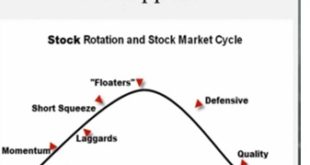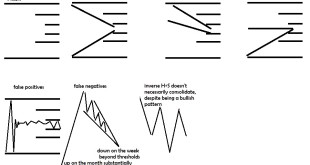Whether you are a day trader or a long term investor, I still suggest you respect trends. I suggest you do it on multiple time frames…
How might you respect the trend? The first step is setting parameters. Trends are never 100% reliable, but they do offer a considerable edge. The thing about being 100% invested is that if stocks go lower you miss out on opportunity as a value investor. Whether it’s the stock you bought or if another great company goes on firesale and is available for a great offer. Not to mention the possibility you are entirely wrong and the trend is false and perhaps even the stock is a value trap…
As a day trader, you have a higher probability of failure and need more cash anyways. A stock you are short ripping 10% higher in a few minutes or a stock you are long shredding 10% lower in a few minutes is still possible. Trading being halted due to fraud, the types of pitfalls are still possible as a day trader. Cash will prevent a “black swan” event from blowing you up or at least reduces the likelihood. In addition you live to fight another day and if you lose fully invested and lose big, there is a HUGE gain that needs to be made up forif you lose. It’s exponentially harder to make up for a loss the greater it is. A 1% loss needs only a 1.01% gain to get back to even a 90% loss needs a 900% gain. Having more cash prevents you from getting to this impossible condition. So set parameters. It’s better to be in cash and 2 relatively independent bets (or safer yet, pair trades) and be leveraged than it is to be 100% long. I say a 25% cash minimum or more makes sense.
You also need a minimum exposure to stocks. Now those willing to go short instead will have a “maximum short exposure” (and minimum cash while short).
In general if you expect the move to the downside to be roughly equal to that of a move to an upside, you probably don’t want to be any more than 75% long or any less than 25% long. That would imply you can be accurate over the long term with this method 75% of the time (unless the move when correct makes a significantly larger move than when incorrect).You may want to throw in some bets to reduce dependency on the direction of the market…
Some ideas:
Earning plays (betting on earnings as well as post earning drifts)
pair trades: (i.e.long copper short copper miners or vise versa based on a thesis)
Arbitrage: This could include a lot of different things)
Value stocks on a very long term basis (over that time frame could outperform and protect you against a brief downward move eventually but also reduce your exposure short)
Shorting soon to be doomed stocks that aren’t priced that way
Day trading stocks,Swing trading and betting for and against stocks on different time frames.
selling puts and holding cash rather than using that cash to buy stocks, or selling calls and holding cash rather than using that cash to short stocks
calender spreads and other option strategies to profit from the function of exponential decay in options.
The lower your correlation between individual stocks and market direction, the better off you will be. This can be explained mathematically when considering what one of the simulations using the kelly criterion showed. It showed that using half the kelly results in 3/4ths the turn with half the volatility. This means lower draw downs and better return on your risk, and you can position yourself more properly for leverage. Think about it this way. a portfolio that returns 6% with a 2% drawdown is better than one that returns 8% with 4% drawdown. You could leverage the 6% return 2:1 and pick up 12% return with the same drawdown (slightly more because of leverage costs).




